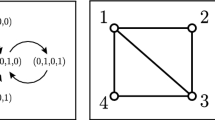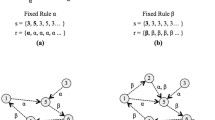Abstract
Limit cycles, because they are constituted of a periodic succession of states (discrete or continuous) constitute a good manner to store information. From any points of the state space reached after a perturbation or stimulation of the cognitive system storing this information, one can aim to join through a more or less long return trajectory a precise neighbourhood of the asymptotic trajectory at a specific moment (or a specific place) on the limit cycle, i.e. where the information of interest stands. We propose that the isochronal fibration, initially imagined and described by A. T. Winfree may be an excellent way to connect directly those two locations. Each isochron is indeed the set of points in temporal phase with one single point of the attractor. The characterisation of the isochronal fibration of various dynamical systems is not easy and until now has principally only been done numerically but not analytically. By integrating the homogeneous solutions of the dynamical system we can solve this fibration in the case of the well known anharmonic pendulum. Other isochronal fibration on classical examples such as the van der Pol system and the non-symmetrical PFK limit cycle are obtained numerically and we also provide the first numerical study on 3-dimentional systems like the anharmonic pendulum with a linear relaxation on its third variable and the Lorenz attractor. The empirical approach seems us useful for dealing with the isochronal fibration which could constitute a powerful tool for understanding and controlling the dynamics of biological or biological-inspired systems.



















Similar content being viewed by others
Notes
If we do know in which isochron the state of the perturbed system is then we know in which point he will join the attractor.
However, an isochronal fibration is continuous, Fig. 1 illustrates this.
exploration (rotations, zooms, ...) and visual rendering (lights and shadows) of the surface.
These entities are null when ρ0 tends to 1. The attractor of the anharmonic pendulum is indeed the unit circle.
References
Bartesaghi R, Migliore M, Gessi T (2006) Input-output relations in the entorhinal cortex-dentate-hippocampal system: evidence for a non-linear transfer of signal. Neuroscience 142:247–265
Ben-Amor H, Cadau S, Elena A, Dhouailly D, Demongeot J (2009) Regulatory networks analysis: robustness in morphogenesis regulation. In: AINA workshops, 23rd international conference on advanced information networking and applications, AINA 2009, Workshops Proceedings, Bradford, United Kingdom, May 26–29, 2009, IEEE Computer Society, pp 924–929
Ben-Amor H, Glade N, Demongeot J (2010) Mnesic evocation: an isochron-based analysis. In: AINA Workshops, 24th international conference on advanced information networking and applications, AINA 2010, BLSMC 2010, Workshops Proceedings, Perth, Australia, Apr 20–23, 2010, IEEE Computer Society, pp 745–750
Bowen R (1975) ω-limit sets for axiom a diffeomorphisms. J Differ Equ 18:333–339
Budelli R, Catsigeras E, Guiraud P (2010) Global dynamics of integrate and fire neural networks with instantaneous strong interactions, (in preparation)
Buzsaki G (1984) Feed-forward inhibition in the hippocampal formation. Prog Neurobiol 22:131–153
Cosnard M, Demongeot J (1985a) Attracteurs: une approche déterministe. C R Acad Sci Maths Série I 300:551–556
Cosnard M, Demongeot J (1985b) On the definitions of attractors. Lect Notes Math 1163:23–31
Csicsvari J, Hirase H, Czurko A, Mamiya A, Buzsaki G (1999) Fast network oscillations in the hippocampal ca1 region of the behaving rat. J Neurosci RC20 19:1–4
Demongeot J, Françoise JP (2006) Approximation for limit cycles and their isochrons. C R Biologies 329(12):967–970
Demongeot J, Kaufman M, Thomas R (2000) Positive feedback circuits and memory. CR Acad Sc Sciences de la Vie 323:69–79
Demongeot J, Glade N, Forest L (2007a) Liénard systems and potential-hamiltonian decomposition. I methodology. C R Acad Sci Math 344:121–126
Demongeot J, Glade N, Forest L (2007b) Liénard systems and potential-hamiltonian decomposition. II algorithm. C R Acad Sci Math 344:191–194
Demongeot J, Ben-Amor H, Elena A, Gillois P, Noual M, Sené S (2009) Robustness in regulatory interaction networks. A generic approach with applications at different levels: physiologic, metabolic and genetic. Int J Mol Sci 10(10):4437–4473
Dinh TP, Demongeot J, Baconnier P, Benchetrit G (1983) Simulation of a biological oscillator: the respiratory rhythm. J Theor Biol 103:113–132
Dinh TP, Demongeot J, Baconnier P, Benchetrit G (2008) A discrete time neural network model with spiking neurons. J Math Biol 56:311–345
Elena A (2009) Robustesse des réseaux d’automates booléens à seuil aux modes d’itération. Application à la modelisation des réseaux de régulation génétique. PhD thesis, TIMC–IMAG, CNRS UMR5525, University Joseph–Fourier, Grenoble, France
Elena A, Ben-Amor H, Glade N, Demongeot J (2008) Motifs in regulatory networks and their structural robustness. In: Proceedings of the 8th IEEE international conference on bioinformatics and bioEngineering, 2008. BIBE 2008, Athens Greece, IEEE Proceedings, pp 1–6
Forest L, Glade N, Demongeot J (2007) Liénard systems and potential-hamiltonian decomposition. Applications in biology. C R Biologies 330:97–106
Freire E, Gasull A, Guillamon A (2007) Limit cycles and lie symmetries. Bull Sci Maths 131:501–517
Glade N, Forest L, Demongeot J (2007) Liénard systems and potential-hamiltonian decomposition. III applications. C R Acad Sci Math 344:253–258
Gluck MA (1996) Computational models of hippocampal function in memory. Hippocampus 6:565–566
Guckenheimer J (1975) Isochrons and phaseless sets. J Math Biol 1:259–273
Hayashi H, Nakada K, Morie T (2007) Moving object detection algorithm inspired by the sequence detection in the hippocampus and its digital LSI implementation. Int Congr Ser 1301:35–38
Hefft S, Jonas P (2005) Asynchronous GABA release generates long-lasting inhibition at a hippocampal interneuron-principal neuron synapse. Nat Neurosci 8:1319–1328
Minorsky N (1960) Theoretical aspects of nonlinear oscillations. IRE Transactions on circuit theory, vol 7, pp 368–381. http://ieeexplore.ieee.org/search/srchabstract.jsp?navigation=no&arnumber=1086717
Mori M, Gahwiler BH, Gerber U (2007) Recruitment of an inhibitory hippocampal network after bursting in a single granule cell. Proc Nat Acad Sci USA 104:7640–7645
Murray JD (1993) Biological oscillators and switches. Springer, NewYork
Nérot O (1996) Mémorisation par forçage neuronal des dynamiques chaotiques dans les modèles connexionnistes récurrents. PhD thesis, Université Joseph Fourier, Grenoble
Osinga HM, Moehlis J (2009) A continuation method for computing global isochrons. Bristol Centre for Applied Nonlinear Mathematics. http://hdl.handle.net/1983/1560
Reyes AD (2003) Synchrony-dependent propagation of firing rate in iteratively constructed networks in vitro. Nat Neurosci 6:593–599
Ricci JCD (1996) Influence of phosphoenolpyruvate on the dynamic behavior of phosphofructokinase of Escherichia coli. J Theor Biol 178:145–150
Samsonovich AV, Ascoli GA (2005) A simple neural network model of the hippocampus suggesting its pathfinding role in episodic memory retrieval. Learn Mem 12:193–208
Tonnelier A, Meignen S, Bosch H, Demongeot J (1999) Synchronization and desynchronization of neural oscillators: comparison of two models. Neural Netw 12:1213–1228
Wilson HR, Cowan JD (1974) Excitatory and inhibitory interactions in localized populations of model neurons. Biophys J 12:1–24
Winfree AT (1967) Biological rhythms and the behavior of populations of coupled oscillators. J Theor Biol 16:15–42
Winfree AT (1974) Patterns of phase compromise in biological cycles. J Math Biol 1:73–95
Winfree AT (2000) Attracting cycles and isochrons. IAM Math Biol. Springer
Acknowledgments
This work was supported by the Virtual Physiological Human Network of Excellence of the European Community (VPH-NoE).
Author information
Authors and Affiliations
Corresponding author
Rights and permissions
About this article
Cite this article
Ben Amor, H., Glade, N., Lobos, C. et al. The Isochronal Fibration: Characterization and Implication in Biology. Acta Biotheor 58, 121–142 (2010). https://doi.org/10.1007/s10441-010-9099-4
Received:
Accepted:
Published:
Issue Date:
DOI: https://doi.org/10.1007/s10441-010-9099-4




